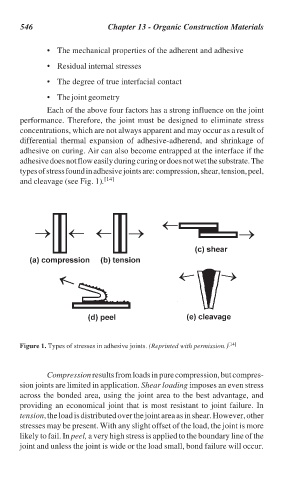Page 576 - Handbook of Thermal Analysis of Construction Materials
P. 576
546 Chapter 13 - Organic Construction Materials
• The mechanical properties of the adherent and adhesive
• Residual internal stresses
• The degree of true interfacial contact
• The joint geometry
Each of the above four factors has a strong influence on the joint
performance. Therefore, the joint must be designed to eliminate stress
concentrations, which are not always apparent and may occur as a result of
differential thermal expansion of adhesive-adherend, and shrinkage of
adhesive on curing. Air can also become entrapped at the interface if the
adhesive does not flow easily during curing or does not wet the substrate. The
types of stress found in adhesive joints are: compression, shear, tension, peel,
and cleavage (see Fig. 1). [14]
Figure 1. Types of stresses in adhesive joints. (Reprinted with permission.) [14]
Compression results from loads in pure compression, but compres-
sion joints are limited in application. Shear loading imposes an even stress
across the bonded area, using the joint area to the best advantage, and
providing an economical joint that is most resistant to joint failure. In
tension, the load is distributed over the joint area as in shear. However, other
stresses may be present. With any slight offset of the load, the joint is more
likely to fail. In peel, a very high stress is applied to the boundary line of the
joint and unless the joint is wide or the load small, bond failure will occur.

